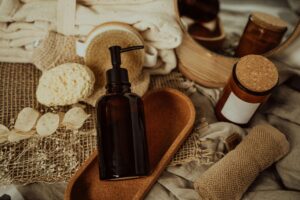You’ve probably heard the term “low tox” before, but what exactly does it mean?
At its core, low tox living is about reducing your exposure to harmful chemicals and toxins in your everyday environment. From the products you use at home to the food you eat and even the air you breathe, the goal is to minimize toxic exposure where possible.
In this post, we’ll dive more into what low tox living is, its benefits, and how you can start your own low tox journey today.
What is low tox living?
More and more people are asking this question as awareness grows about the hidden toxins in our homes, food, and personal care products.
Low tox living means making conscious choices to reduce your exposure to harmful chemicals, creating a healthier environment for you and your family. It’s not about striving for perfection or completely eliminating toxins overnight—it’s about taking small, manageable steps toward a cleaner, more natural lifestyle.
Benefits of a low tox life
Why should you care about going low tox? The answer is simple: it can significantly impact your health and the health of your loved ones. By reducing toxins, you can support your body’s natural ability to detoxify and function optimally.
Here are some of the key benefits of adopting a low tox lifestyle.
Better health
Many of the chemicals found in everyday products are linked to a wide range of health issues. From hormone disruption to respiratory problems and even long-term conditions like cancer, the risks associated with prolonged exposure to these substances are well-documented.
Common culprits include phthalates, formaldehyde, and parabens, which are often found in cleaning supplies, personal care products, and even food packaging.
When you choose low tox alternatives, you’re significantly reducing your risk of coming into contact with these harmful chemicals.
By making these swaps, you’re supporting your body’s ability to regulate itself naturally, improving immune function, balancing hormones, and minimizing inflammation.
Cleaner home environment
Your home should be your sanctuary, but it’s often where toxins accumulate without you realizing it. Household cleaners, air fresheners, furniture, and even flooring can introduce a cocktail of chemicals into the air and onto surfaces.
These toxins can contribute to indoor air pollution, which the EPA states can be more harmful than outdoor air pollution.
By switching to low tox cleaning products, using natural materials for your furnishings, and even choosing organic linens, you can create a much healthier environment inside your home.
Eco-friendly choices
A low tox lifestyle often goes hand-in-hand with making eco-friendly choices. Many products that are low in toxins are also better for the environment, as they are typically made from natural, sustainable materials and have a lower carbon footprint.
For instance, choosing biodegradable cleaning products or packaging made from recycled materials helps reduce the strain on landfills and the planet.
When you opt for low tox alternatives, you’re contributing to a more sustainable future—not only for yourself and your family but for the world as a whole.
Improved skin and overall well-being
The skin is the body’s largest organ, and it absorbs many of the substances we apply to it. Unfortunately, many conventional personal care products contain chemicals that can be absorbed into the bloodstream and cause harm.
Ingredients like sulfates, synthetic fragrances, and parabens are common in shampoos, lotions, and cosmetics, and can lead to skin irritation, allergies, and long-term health concerns.
Switching to low tox personal care products reduces the number of harmful substances your skin is exposed to, leading to fewer breakouts, irritation, and dryness. In turn, you’ll likely notice a healthier, more radiant complexion and overall well-being.
Additionally, reducing toxins in your home and lifestyle can lead to improved mental clarity, better sleep, and a greater sense of well-being. When your body is less burdened by harmful substances, it has more energy to devote to healing, restoring, and thriving—allowing you to feel your best both inside and out.
How to start your low tox journey
Transitioning to low tox living should feel empowering, not stressful. It’s all about taking small, consistent steps that can have a big impact over time. Here are some simple steps to help you get started:
1. Begin with the basics
Start by identifying areas in your life where toxins are most prevalent. Think about the cleaning products you use, personal care items, and the foods you eat. Instead of tackling everything at once, choose one area to focus on first.
For many, cleaning products are a good starting point because they can contain harsh chemicals that impact both air quality and skin health. By switching to natural alternatives like vinegar, baking soda, or essential oils, you’ll immediately start reducing the number of toxins in your home.
Another area to consider is personal care items like shampoo, deodorant, and makeup. These products often contain synthetic chemicals that can disrupt your hormones and irritate your skin.
2. Switch to low tox alternatives
Once you’ve identified the high-toxin areas in your life, begin swapping out products for low tox options. This might feel like a big change, but it doesn’t have to be expensive or overwhelming. Start with simple swaps.
For example, instead of conventional cleaning sprays, opt for natural products made from plant-based ingredients, or make your own with items like lemon juice and castile soap.
When it comes to personal care, look for brands that avoid parabens, phthalates, and synthetic fragrances, and choose products with recognizable, natural ingredients.
When shopping for food, opt for organic produce when possible, especially for items like strawberries or spinach, which are more likely to contain pesticide residues.
Over time, you’ll learn which low tox products work best for your lifestyle and budget.
3. Educate yourself
One of the most powerful tools on your low tox journey is knowledge. The more you understand about the ingredients in the products you use, the better equipped you’ll be to make healthier choices.
Start by reading labels—if you can’t pronounce an ingredient or don’t know what it is, take a moment to research it. You might be surprised at how many products contain toxic ingredients that could affect your health.
Fortunately, there are plenty of resources available to help guide you. Apps like Think Dirty or the Environmental Working Group’s (EWG) Skin Deep Database can provide you with easy-to-understand ratings of products and ingredients.
4. Don’t stress about perfection
One of the most important things to remember on your low tox journey is that it’s not about being perfect. Trying to eliminate every single toxin from your life can quickly become overwhelming, and that’s not the goal. Instead, focus on making progress and reducing your exposure where you can.
Whether you switch to natural cleaning products, cut out processed foods, or start buying organic shampoo, each small step adds up over time. Give yourself grace as you make these changes, and celebrate each victory, no matter how small.
Get started today
Exploring Low Tox & Thrive is a great first step on your journey toward better health—we’re grateful to have you here! Here are some more resources to help you get started:







